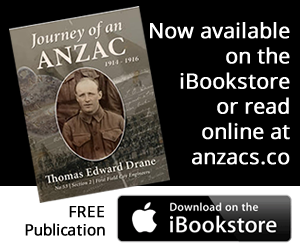Day 1 – Arriving in Papua New Guinea
March 6, 2009 by WebMaster
Filed under Forbes to Kokoda & Back
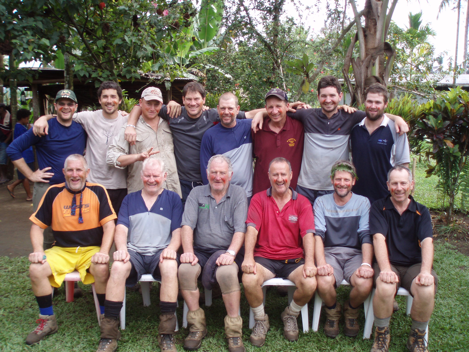
Back (L to R) Andrew Drane, Josh Baker, Steve Cook, Ian Bown, Scotty Reid, John Milton, David Hoggets, Zac Rennick. Front (L to R) Ralph Baker, Norm Cook, John (Tractor) Rennick, Michael (Harry) Walker, Peter Hollstein, Viv Russell.
We arrived in Port Moresby on the 20th of July 2007. The first thing that hit me was the heat. We knew it would be warm and the hot wind hit us straight of the plane. This was different coming out of our winter. It was my first time out of Australia so all the forms and customs check were expected but time consuming. The whole team was upbeat and positive. We all knew it would take time just get through it. As Harry said the two P, s. patience and passports and you can go anywhere.
We were all there Myself, Michael Walker, Norm Cook and his son Steve, , John Rennick and his nephew Zac Rennick, Scotty Reid, David Hoggets, Peter Hollstein, John Milton, Viv Russell, Andrew Drane and at the airport to meets us was Ralph Baker and his son Josh. They had gone up there on the Monday and spent time at Mt Hage and driven down to Lea. Ralph had a brother that worked there many years ago, so they went to have a look around the place.
We were met at the airport and taken to our hotel by the courtesy bus. This was the first of many mini bus trips we were to take and most of them were all the same, crowded and very noise over very rough roads. The good roads lasted about 100 yards from the airport terminal and it is the same all over New Guniea.
The Gate Way Hotel was a quality motel even by Australian standards. Given our rooms (I was roomed with Scotty) we assembled in the bar (as you do) for a little drink and a talk to wait for dinner, and our Tour host to give us a brief of our trip.
While in the bar we found Max and Mary Leighton, our fellow trekkers from Perth.
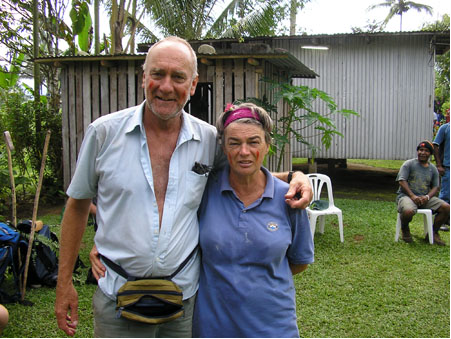
Max and Mary
Time for our meeting had come and gone and we were to find out this quite normal in New Guinea. Papua New Guinea time is very different to home. It’ll happen eventually. They turned up about 7.30 pm. We had our meeting and dinner. Then we all met Max our Papua historian and Phillip our head guide. We didn’t know at the time but this Phillip was full of surprises.
Most off us went of to our rooms to check our gear and sleep for the 6.30 start. Of course there has to be someone who is led astray and poor old Norm found a couple more drinks and a small trip to the night club too much to resist. The problem was he took Tractor with him. Well it made for lots of banter for many a day later.
During the day we had a sight seeing tour of the Borma war cemetery and memorial. It was about half hour drive from the hotel out the road to Owens Corner. I didn’t know how I would feel when I got there. I had seen pictures and googled it but had no idea of the size. The size of the place and all the head stones hit me the most. I had read a fair bit about it and knew where some of the graves of well known soldiers were but there was just so many. I wandered off on my own, for a while just to get a feel for the place; it was a very humbling experience. It was of special sugnifance to Viv as his father in law has two brothers buried there. Both joined the same day with consecutive numbers and sadly both died the same day in the battle for Oviv Village. More on Oivi Village later. Viv found their graves and got photos for the Family. They are Simmonds of Bedgerabong. We found the grave of Bert Kingsbury the VC winner. It has the VC insings on the head stone. Just behind and about half dozen head stone along is Butch Bissett head stone. Butch was killed at the battle at Isurava and is talked about at length by Peter Fitzsimmons in his book Kokoda.
We all signed the visitor’s book and left a small note. I just said (Hi mates from Uncle Trevor and Lawry. Both had gone over the track back in 1942)
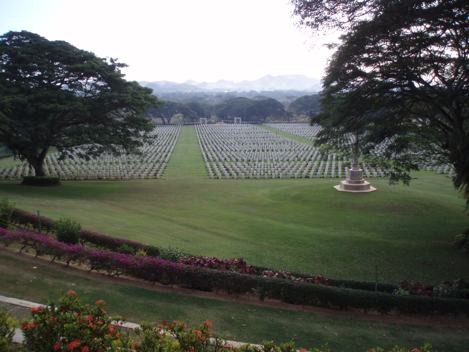
Borma Cemetary
I then had a walk up the hill past so many who were all so young. A moving experience. It is a credit to the Papuans who look after it they do a wonderful job.
Back on the bus for a tour of Port Moresby. What a poor backward city. Roads are in very bad shape, lots of people everywhere. Markets were all over the place. Anybody can ride in any vehicle in any position on the back of anything. Trip to the food store for supplies. There was so many people about. Very few whites to be seen. Every corner seemed to have a large gathering of locals, just standing around with not much to do. Ralph told us about the beetle nut they chew. The nut comes in a shell about the size of your thumb. They chew it with a mustard herb grown in the ground and a form of builders lime. It gives them some form of kick, the side effect is there mouth and teeth go sickly bright red for some time.
The supermarket was for the whites and upper class blacks, there were security guards all round it. Lot of barbwire fences around many of the compounds. Not much done since independence around Port Moresby.
Story written by Ian Bown of Forbes
For more pictures visit the Kakoda Gallery
Day 2 – Owens Corner to Ua-Ule Creek
March 6, 2009 by WebMaster
Filed under Forbes to Kokoda & Back
Wheatbix, two fried eggs toast and coffee. What a breakfast, last good one for a week. Very excited let’s go I thought. The two trucks arrived eventually, did I mention New Guinea time yep. One truck was empty for us and the second one had 20 porters hang out of it. No sooner had it stopped and out they poured out grabbing our gear and loading straight on. The trip out to Owens Corner took about two and half hours I think. The road started ok but then fell away to a rough track. Scotty was sitting next to me and spotted a LPG bottle hanging from a tree like a punching bag. He reckons they must be tough up here. We passed McDonalds corner where B Company had to walk passed. The photo is in the book Peter has with him. Passed a cattle station although it many not be used for that anymore hard to tell. Arrived at Owens about 10.00 am I think. Unloaded and walked down a small track 200 yards to the start. A small flat ¼ acre block before you fall into the abyss. Final gear check, and introduced to all the porters. We were all given a porter here if you wanted to have one carry some of your gear. Then we went along and were introduced to each porter by name. At this time a group came over the lip of the cliff just finishing their trek. They had Lots of high fives amongst themselves
And then they gave a little insight into what the track was like. After a group photo with the porters in front of the Owens Corner sign, the porters sang us a song. I thought that’s nice I had seen that sort of thing on my net searches. Little did I know it was their theme song and it would be a big hit on the track.
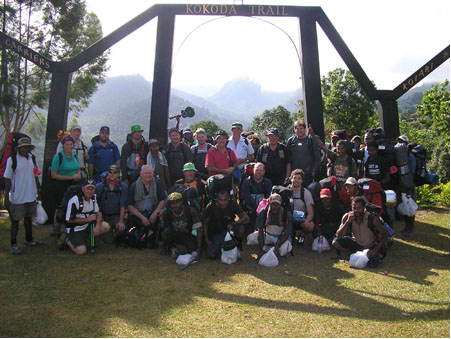
Loaded up and ready to roll
Loaded up and over the abyss we all went. It was a steady climb down for half hour (I say climb down because you only do two things on the track, climb up or climb down. There is very little flat.) . To our first stop the Goldie Creek. Shoes off and wade through. Goldie Creek was a major staging point and aid post in the war.
We had lunch at the Uberi village. No one lives there anymore. It has a few buildings for the trekkers to lunch and rest at. This was a major place in the war. The Japs never made it this far, so it could be used by the diggers for first aid and supply dumps. Viv had found a small pocket knife when crossing Goldie Creek so Peter and I carved names in our stick. Peter put his dads, nickname (Stingar) on his and I put the initials A.B. & L. T. for dad and mums two brothers Laurie and Trevor who both fought on the track.
Then before I realised it we were on the Golden Stairs. It seemed strange because all I had read and the pictures I have seen show a log stair case up the hill. There is none of that there now, just a long winding vertical hill going up 450 metres high to the top of Imita Ridge. The climb was hard because we all got excited and went a bit hard at it and it was our first climb. A very narrow winding snake of a track up to the top. A lot of clay in the soil so it made good foot holes, but just so many of them. It was this first hill that the hiking order was unofficially formed with the young guys up front and us forty year olds in the middle followed by Norm and Tractor. We thought this is how it would be and it just fell into place with no words said. Just the way it was. We waited for Norm and Tractor to get to the top, with the porters giving them a big welcome with the word oro oro (pronounced OR-O OR-O eg, welcome or hello depends who you ask). Norms, now famous words don’t break the golden rule no drinking the night before you start. We hear this all week.
Rested up we head down the ridge to our night camp at Ua-Ule creek. The trip down was ok, very dry which made it like slippery gravel under foot. We all made it ok only Viv right in front of me slipped with his sticks and slid over the edge and down the hill. Viv slid about 5 feet but jumped back up quick as a wink and he was good as gold.
The overnight stay was good. We had a swim in the creek washed clothes and relaxed. I pumped up a footy and the young boys had a pass around with some of the porters. We bought some coke and the village people brought out some beers (SP the local drop) for sale, well they didn’t last long. There was only a few. All in bed by 7.30 pm. My first restless sleep, the first of seven straight.
Story written by Ian Bown of Forbes
For more pictures visit the Kokoda Gallery
Day 3 – Ua-Ule to Naoro Village
March 6, 2009 by WebMaster
Filed under Forbes to Kokoda & Back
Phillip would the give his summary of the days trek. We would ask him how long it would take from this point to the next; he would make a comment like about 1 ½ hours. This means in village time 45 minutes to 2 and half hours. We got used to it pretty quick, and then we just play along when they gave us a time for a section of the track. Time has no place up in the mountains. You get there when you get there and stop when they say stop.
By this time we had a running joke going with our guide and historian Max. (Max is a Villager too.) What is the Track like today Max, well it’s a little bit up, then a little bit down, then a little bit up, then a little bit down. This all came from the day before when in all seriousness he tried to explain the days march in that very exact manner. He also asked someone what 45 minutes and 15 minutes were, we answered 60 minutes. So Max says in all serious we have 1 hour 60 minutes to go. Ok that set the trend as well. It was all good fun.
Phillip explained it was going to be a big day. We started the day at 300 metres by mid afternoon we would go over the peak at Maguli range at 1320 metres. We followed the creek for a short time first, and then up we went for 2 hours to the ridge of Ioribaiwa. A climb of 550 meters. This is the furthest point the Japs got to Port Moresby. You could look back and see Imita Ridge. We had covered 10 kilometres, and taken 1 ½ days to get here. We stayed there for ½ hour to look around let every body catch up. The village people had a lot of old bits and pieces from both sides. Old bombs, helmets, rifles and other things. A lot of fox holes in this area, the boys got some photos sitting in the holes and of the view back to where the Japs wanted to get to. A lot of action on this hill. The Japs shelling the Aussies with their guns and for the first time our 25 pound guns hit the Japs on this hill.
When the Aussies retook this hill and the 2/6th field Ambulance arrived Clem Makings, recorded this poem in his diary.
WX-UNKNOWN
We knew he came from W. State
Though to us he remained unknown,
For the WX was marked on his hat,
The rest a mortar had blown,
We buried him there on a mountain spur,
Where the trees are draped with moss,
We thought of the mother, no news for her,
Of that irreplaceable loss,
Just a boy he looked with his snowy hair,
So we laid him in the clay,
The padre’s voice was loud and clear,
No others had words to say,
Yet we new a mother would watch and wait,
For a letter sent from her boy,
How she would dream of the things he did,
How his first words caused her joy,
Perhaps she will know in some unknown way,
Of the little rugged cross,
The remains of her hero, under it lay,
Where the trees are draped with moss,
We cursed the heathen, who striped the dead,
No pity on them can be shown,
We marked the cross so it can be read,
WX-UNKNOWN
After that it was head down and climb down the too Ofi creek for lunch. This was not long but steep and tricky. Ofi creek has a magnificent Guest house sitting on the side of the hill as you come in down the hill too the creek very impressive. We had lunch there, about an hour’s break and a wade in the creek for the feet the get ready again.
Well we didn’t know what was to come after lunch, but we found out it was a 750 meter climb. We climbed out of Ofi creek straight up another very snaky track for 300 metres. After this steep section it got a bit easier, but it was still a very hard slog. For the rest of the afternoon we just climbed up and up to the top of Maguli Ridge. About 200 or 300 meters short of the ridge there is a flat bit of ground. Its about 40 meters square and this was a Jap command post. The next section of track is what Max and Phillip referred to as the Jap ladder. They had been telling us about this but not in much detail, now we know why. It is a vertical bit or track going up about 80 to 100 meters. It has steeps cut into the clay soil and so steep they called it the ladder. It was a hard little climb, but not too long thankfully. It would be extremely difficult in the wet like the diggers did it.
When almost to the top of the ridge there was wooden cross left by the porters at the side of the track. Phillip informed us his was a trekker who had a heart attack and died at the spot.100 meters short of the top of the ridge. At the top there is a clearing, so we all rested and Phillip gave us the story of the trekker. I think he said about 6 to 8 months ago it happened. They air lifted the body out from this clearing. There is also a very large tree right at the top of the ridge. This was where the Aussies put a machine gun nest during the fight and were able to spray the whole area when the Japs advanced. How they did it? Well it was a good effort. From here we had a long down hill climb to the old Naoro village. We passed the new Naoro Village that was built after the war due to the fact the villagers wouldn’t stay at the old places due to the fighting that took place. The creeks were running with blood. Bad taboo.
We arrived about 4 or 5 o’clock I think, about 10 hours on the track. We were a bit worried about Tractor as we hadn’t seen him, since lunch and he did it tough the first day. Then Tractor arrived a bit later going pretty good, tired but feeling ok. So the porters felt he would make it through, just taking it steady.
Everyone was unpacking their gear and setting up camp for the night. Milto noticed Peter had no gear. He informed us his porter James has gone walkabout. It was James first trip over the track and he had got lost at the fork in the track about one kilometre short of the camp. It was about two hours before they found him and got him back to camp.
Lots of kids at the guest house area so I gave them a Dragons footy, what else?
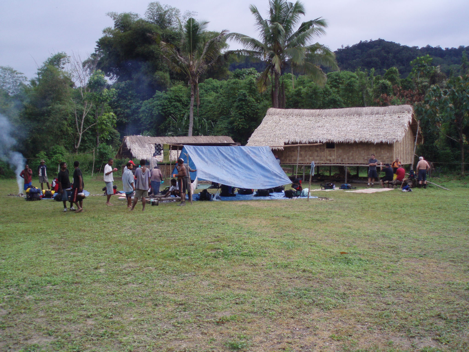
Nauro Village
Story written by Ian Bown of Forbes
For more pictures visit the Kakoda Gallery
Day 4 – Old Naoro to Efogi Two
March 6, 2009 by WebMaster
Filed under Forbes to Kokoda & Back
We had two big climbs the Menari Ridge and Brigade Hill. Over the Menari Ridge down to Menari Village for lunch and we would decide, if we go on to Efogi for the night. It was about this time that a porter by the name of Mansoon took over the job of lead porter for the rest of the trip. He was about 40 years old with a lot of experience in the hills but it was only his second trip across with trekkers. He was one of the main singers and full of fun. Horse, The Golden Child and Josh, taught Mansoon to say, Rock and Roll whenever we were starting up from a break. Well he had a bit of trouble with the word rock so it got shortened to Wok and Roll and that was the call up front. They also made up a lot of bird calls for fun and would yell out along the track. The porters loved it and you would here them yelling out from up to 100 to 150 yards down the track or was that Harry, hard to tell when out of site.
A short walk from Nauro village through some swampy country and we came to Brown River. Boots of and wade through we went. It would be a big river in flood. Only 350 meters to the top of Menari ridge. Not long but very steep. We were heading down now to the Menari Village for lunch.
Just before we got to the village there was a creek with a fairly easy log crossing. This creek also floods so they have a high log crossing so as to cross when water is high. The log is about four inches wide and about 12 feet up over the rocks below. No one tried that one except Josh. He went pretty well till about half then slowed a bit and got a bit shaky in the legs. He regrouped and made it across. I think it was Mansoon that went out on the log just in case. Then just to show what can be done, Phillip walked across the log in two seconds flat as if it was flat ground. He wasn’t asked he just had to get across the creek.
The group had broken up a bit coming into the village, and I was with Max, Mary and Ralph. The village opened up to be quite large with a footy goal post in the middle and about 20 kids playing about. So Max suggested if I had another footy the kids may have some fun. So I pumped up another footy, (Dragons of course) and once the kids saw a football they came running. We kicked it into the middle and like ants they were everywhere. We kicked it about with them for a few minutes then wandered through the village.
We got a call from a hut and an old Fuzzy Wuzzy was up there waving from a window. He came down to meet us, he had his medals on and patches all over his shirt, we think he was fairdinkum. We just don’t know however as he spoke no English. We got photos with him anyway and he was full of smiles a real legend.

Mary, our Fuzzy Wuzzy, Ian and Ralph.
After lunch we moved on to take on Brigade Hill and onto Efogi village for the night. Brigade Hill this was the big climb. It was 700 metres with no small downs at all just up and up for 700 metres. We had all gone a fair way we thought almost an hour when we stoped for a break. Derrick comes along the No 2 guide and tells us we are ¼ way to the top. Well that went down well. So that was it we just kept climbing up and up to the top. It was probably the hardest climb I did, but about 2/3 thirds the way up we came to a gap in the trees. This same gap was pointed out to us 2 days earlier from a long way back. Tassie my porter pointed it out back then and said we would be going through it but it seemed a long way away back then.
After about two and a half hours climbing we reached the top. It was a spectacular view of the ridges in all directions. There is a plaque at the top explaining what happened there in the battle. We had no idea how tough it was for the soldiers back then but the terrain has not changed much since. I have no idea how they managed to dig into the bush to fortify for battle. We had the book to spot where the companies were but you just can’t believe how tough the terrain is. It was a very important hill as it controlled the high point for a fair way around.
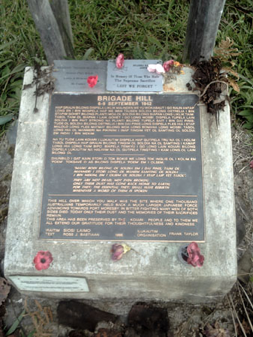
It had taken us three long days to get to this point. We had done this in dry conditions. Looking back now I think we had just completed the hardest part of the track. We had porters to lighten our load a bit, so how the diggers did it in day light and dark and in the rain and mud, with full packs and guns. You have to have experienced it, to have any idea how hard it must have been. They certainly had what the Isurava Memorial says.
Max gave us our history lesson, although I think he was a bit sketchy on detail, but this was common for Max. We didn’t mind he gave it his best shot. From here it was all down hill to Efogi Village, even though it was still another hour away. It is not the same track from here to Efiog as the soldiers used that was shut down by the villagers after the war.
Devils Corner (it was given that name during the war) they call it, a very tricky climb down, very steep and very narrow with a big drop off to one side. Anyone who has done the trek would know it well. How they ever got stretchers with wounded up there is beyond belief. It was pointed out to be very careful as a lady trekker before us had gone down the side once before.
The war time name for this section was Mission Ridge. This is where the war track joins the current track. You can see the Kagi airfield from this spot. Efogi airfield is still out of sight. There was a Seventh day Adventist Hut near here during the war. I suppose that was where Mission Ridge came from.
We all arrived safely at Efiog very late and very tired. Efiog is the biggest village on the track with a good airstrip. Another feed and early to sleep. Each night meal consisted of rice either steamed white rice, cooked just like Nella Bown does and very tasty. We had a Mexican rice of some kind one night that was nice too. That was with pasta of some kind it was only ok but I had it any way. You could always get Bananas and oranges at each village and they were always at the dinner table each night. They made a great Billy tea, black and 2 sugars. We were all looking forward to tomorrow as it is only a short day 5 hours. But first the food drop.
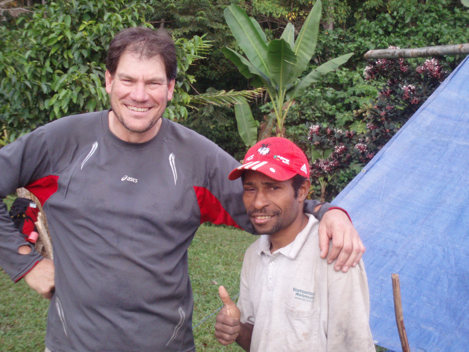
Ian & Casmiro
My porter, Casmiro Maia and Myself. We called him Tassie. He had a sore eye the whole trip and it was almost closed by the time we finished. Every time I asked him how it was, he would just say, its ok, I be ok. Tough little bugger. I could tell it was painful for him. He used up all the Panadol I could find for him.
It was the Dragons cap I gave him that gave him the inner strength.
Story written by Ian Bown of Forbes
For more pictures visit the Kakoda Gallery
Day 5 – Efogi 2 to Kagi Village
March 6, 2009 by WebMaster
Filed under Forbes to Kokoda & Back
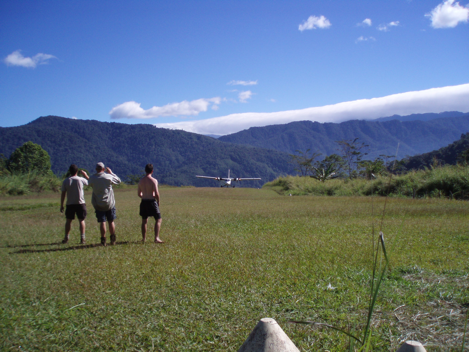
Josh, Steve (The Golden Child) and David (Horse) standing where the plane finishes. The plane was starting to get close.
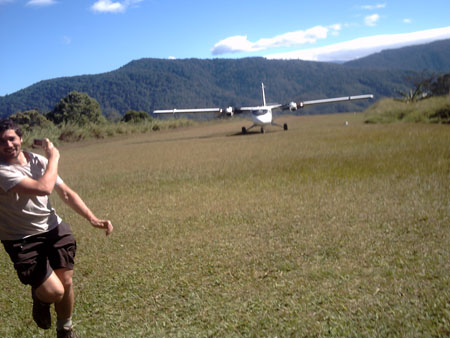
Josh said Oh Shit!! Time to move.
Back up to camp and the porters sorted out all the supplies and off we went. Only a half hour climb up to our first stop at Efogi Village No 2 where we had an early lunch as it was the last stop before the finish of the day. At Efogi No 2 village there was a few kids and one little girl, she was about one and half years old dragging around a machete about the same size as her. Look strange to us but they were not worried.
We climbed down to a creek that had a good size log crossing. The young guns were standing on the other side when I got there, so I wet my towel and shirt rather than going for a swim like I felt like doing as it was very hot and that was my mistake. This next climb was the last of the day up to Kagi village but it was steep.
Not a long climb 420 meters but straight up and tricky, very snaky wet ground. There was a creek running down the hill to the other creek. No picture can do it justice. Very picturesque, but a tough climb. We were right in amongst the trees here very thick scrub. Wet slippery ground due to no sunlight. The track kept switching back on itself. You could see someone 30 meters above you but you would walk 80 meters to get to that height. About an hour and half climb and we came out at Kagi airstrip at the base of the village. This is Max’s home village so they were happy to see us. Clean and tidy about half the size of Efogi village.
Being finished early was a chance to relax and wash. But the water broke down so we had to wait till later when it got fixed. Milto found some cokes so we had drink and relaxed. While Milto was getting the cokes he also found Max’s Brother who also lived in the village and while he was talking to him, he found out that he had a son named Trent. Named after Trent Barrett the dragon footballer. (True story). So he brought him down to meet us dragon supporters, to see if we had anything for him. I had a new dragon’s cap in the pack, so Milto and I had a photo with Trent and his new cap. Last seen heading up to mum and dad with a big smile on his face.
We all had a big fresh dinner that night due to the new supplies, Curry chicken and steamed rice, best feed of the walk and the porters had there first and only big meal of the trip that I saw. They were full of good cheer that night, they sang and danced for long into the dark that night. They maybe had some extra smokes I think. (Their special smokes)
Story written by Ian Bown of Forbes
For more pictures visit the Kokoda Gallery
The Old Soldier
March 4, 2009 by WebMaster
Filed under Bush Poetry, The Old Soldier
You won’t have any trouble believing that this poem was written about someone close. It remains an issue close to Ron’s heart that a man (like thousands of others) gave his youth for this country, only to be a misunderstood in their old age. The war was hard enough to fight at the age of nineteen, let alone in their seventies. I have seen this poem recited to an Anzac day audience of over three hundred and there was not a dry eye to be found.
Bush poetry by Ronnie Wilson
It’s Tuesday the Third of March, Nineteen Hundred and Ninety Eight,
An old soldier died this morning, fifty-three years too late.
And the nurses in the nursing home hated to be near him,
‘Cause he’d spit and curse and fume, and cause a mighty din.
And the doctors were glad to see him go, he was dangerous in their eyes,
He’d knocked one out with a single blow, and he was twice his size.
And when he’d snarled at visitors, and spooked the other old folks,
They took away his privileges, his magazines and his smokes.
And they lectured him on manners, and called him a disgrace,
When at night he woke from screaming, lathered in sweat, pale faced.
An old soldier died this morning, fifty three years too late,
But the nursing home’s not mourning, for the latest turn of fate.
And the doctor chatting to the pretty nurse, has something else in mind,
Cause soon he’ll be on the golf course, with others of his kind.
And from cross the road, the wind will bring the sound of children’s laughter,
And in the tree’s the birds will sing, and will forever after.
The day goes on and before very long, the passing might never have been,
No lasting sorrow nor mournful song, for nasty old men it seems.
So go and put him in the ground and mind you bury him deep,
That way we won’t hear the sound, of him screaming in his sleep.
An old soldier died this morning, fifty three years too late,
With no regrets in going, nor pity at his fate.
But what cruel trick life gave him, and who designed the law,
That would slip his mind back in time, and make him relive the war.
Back to the tropical jungles, with sweat and mud and rain,
Back to the yellow terror he visits again and again.
Where the very land around him is trying to kill him as well,
With the crocs and snakes and malaria he lives in living hell.
It’s no wonder he was cranky in his final golden years,
When he heard the screams of the dying in his nightly sleeping ears.
An old soldier died this morning, fifty three years too late,
His mind went back to war in ninety-seven and ninety-eight.
And the sight of the gardener pruning in bushes on bended knee,
Was to him the enemy sneaking, as plain as plain could be.
And when the Docs came to get him he caused such trouble and strife,
But little did they realise he was fighting for his life.
And so he suffered daily at the hands of a hidden foe,
Hunted and haunted nightly by fears we’ll never know.
Why now so many years later should he fight all over again?
When surely he has already fought, more than most other men.
An old soldier died this morning, fifty three years too late,
He spent three years in Changi, Weary Dunlop was his mate.
And the Burma Rail was built with blood of men that he called mates,
And all of those men and most of his sight was lost behind Changi’s gates.
And though he lived over fifty years past the end of that terrible place,
That a part of him had died there was written on his face.
And fifty years of silence had its own nasty price,
Because in one single lifetime he had to live it twice.
Rest in Peace now old soldier you have deserved it yet,
And may the rest of us remember, Lest We Forget.
© Ron Wilson
The Bushman
March 4, 2009 by WebMaster
Filed under Bush Poetry, The Bushman
Long have the legends of Clancy, and Snowy River dominated bush culture. The reality is, that that sort of courage has been and is faced every day by all types of Australians.
On a warm and dusty morning at a campsite west of Bourke,
Two bushmen caught their horses and set about their work.
They only spoke as needed, and then, only just enough,
To see the job completed, or an occasional nervous laugh.
For today they’d drove a long dry stretch, to the next known watering spot,
But the mob in tow was barely alive, and the track so dusty and hot.
And if the hole they sought was also dry, it was more than the mob they’d lose.
But to stay here meant they’d certainly die, so the track was easy to choose.
On a wet and misty morning at a hide out south of Bourke,
Two bushmen caught their horses and set about their work.
They only spoke as needed, and then, only just enough,
To see the job completed, or an occasional nervous laugh.
For today they’d ride against the law, their children for to feed.
With a life of hunger still in store, they’d steal for want and need.
And if today a traps bullet finds, the Bushrangers mortal end.
The only regret they’ll have in dying, is leaving their wives to fend
On a cold and frosty morning in the ranges East of Bourke,
Two bushmen caught their horses and set about their work.
They only spoke as needed, and then, only just enough,
To see the job completed, or an occasional nervous laugh.
For today they’d cross a rivers flood and a snowy mountain peak.
Cold and wet and covered in mud their horses sore and weak.
To fetch the doc and bring him back, their mother was gravely ill.
No time to take the normal track when an hour could easily kill.
On a calm and peaceful morning at a war, long way from Bourke,
Two bushmen caught their horses and set about their work.
They only spoke as needed, and then, only just enough,
To see the job completed, or an occasional nervous laugh.
They checked the straps and ammo, and memorized the plan.
Then swore allegiance to each other, and vowed to make a stand.
They sprung lightly to the saddle to face this life’s last test.
Then charged the machine guns rattle, “Light Horsemen” at their best.
On any dawn of any morn on any track from Bourke,
The bushmen catch their horses and continue with their work.
And they’ll always be there as needed till their hearts of gold all spent,
Find its time to meet their maker and pay their final rent.


